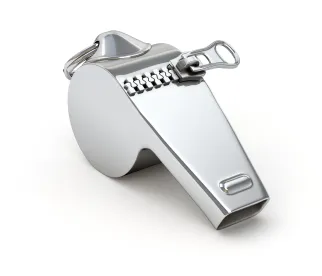The “pilot” Severe Violator Enforcement Program will impose more stringent inspection procedures, enhanced settlement provisions, and “public scrutiny” for employers that OSHA deems to have engaged in “egregious behavior and blatant retaliation against workers who report unsafe working conditions and violations of law” under the 22 whistleblower statutes enforced by OSHA.
Background
In its most recent effort to expand its Whistleblower Protection Program, the Occupational Safety and Health Administration (OSHA) announced a new “pilot” Severe Violator Enforcement Program (Whistleblower Severe Violator Enforcement Program or W-SVEP) on May 31.[1] Effective May 27, OSHA’s W-SVEP will be in place for four years in Region VII (Kansas, Missouri, Nebraska, and those companies under federal enforcement in Iowa). Among other things, the W-SVEP will impose more stringent inspection procedures, enhanced settlement provisions, and “public scrutiny” for employers that OSHA deems to have engaged in “egregious behavior and blatant retaliation against workers who report unsafe working conditions and violations of law” under the 22 whistleblower statutes enforced by OSHA.[2]
Substance of the New Program
OSHA outlined its new program in a Regional Notice[3] and a Regional News Release[4] published on May 31, 2016, a few days after it became effective. According to the program, OSHA now will place employers on a W-SVEP Log (i.e., a public watch list) when an OSHA investigation under any of the statutes administered by OSHA results in any of the following:
-
A merit whistleblower case directly related to a fatality
-
A merit whistleblower case involving an egregious safety/health enforcement case
-
A merit whistleblower case where the employer has a rate-based incentive program for reporting injuries
-
A merit whistleblower case where the employer is on the Log for OSHA’s general health/safety Severe Violators Enforcement Program (SVEP Log)
-
A significant whistleblower case
OSHA also will add employers with three or more merit whistleblower cases in the last three years to the W-SVEP Log.
Several of these criteria are ambiguous and, as a result, raise serious questions about how the program will be implemented. Most notably, it is unclear what level of causation makes a case “directly related to a fatality” or what constitutes an “egregious safety/health enforcement case” or a “significant whistleblower case.” Also, it is unclear whether the “three or more whistleblower cases in three years” threshold applies to a single site or to multiple sites of a single employer.
Once an employer is on the W-SVEP Log, OSHA will publicize the employer’s “egregious behavior.” Specifically, OSHA will issue a press release announcing the employer’s inclusion on the W-SVEP Log and then send the press release and the investigation results (either from the US Department of Labor [DOL] or a federal district court) to a number of entities, namely the employer’s headquarters, the federal agency with primary enforcement over the type of complaint filed (e.g., the US Securities and Exchange Commission, US Department of Transportation, Nuclear Regulatory Commission [NRC], Federal Aviation Administration, US Food and Drug Administration, etc.), all labor unions within the employer’s facility, and all DOL agencies with jurisdiction over the employer’s facility. Additionally, OSHA will refer the employer to its Safety and Health Office to determine compliance with 29 C.F.R. § 1904.35—a provision requiring employers to inform employees how to report an injury or illness, among other things.
Removal from W-SVEP
Once on the W-SVEP Log, there does not appear to be an easy or clear way for an employer to be removed. According to the Regional Notice, employers have two options—either a favorable court determination or a formal request from the employer. With respect to the first option, an employer will be removed from the W-SVEP Log if a court finds the whistleblower allegation at issue lacks merit or reduces damages to a level that is below a certain threshold. But it is unlikely that this will be a practical option, because whistleblower cases generally take several years to reach a court resolution, if they reach one at all.
The second option also presents a number of practical challenges for employers. This option requires an employer to complete a complicated “follow-up process.” Specifically, after three years on the W-SVEP Log, an employer may send a written request to the regional administrator for a follow-up investigation. The regional investigator then will conduct the follow-up investigation and evaluation of that employer’s worksite, which includes employee interviews to ensure that the employer has implemented changes in the workplace such that a “chilling effect” does not exist.
OSHA does not define the term “chilling effect.” The NRC has defined the term and members of the commercial nuclear industry are familiar with it. In this context, the term refers to a work environment in which individuals are reluctant to raise concerns for, among other reasons, fear of retaliation. Up until now, the NRC was the only federal agency to go beyond prohibiting retaliation in adopting a policy that, in effect, requires companies to establish and maintain a work environment in which individuals feel comfortable raising concerns without fear of retaliation.[5] OSHA now appears to be following suit, which creates significant implications; this policy would now apply to all private sector employers (rather than a relatively small, heavily regulated industry) with OSHA’s authority expanding into all workplaces. This level of review is unprecedented—OSHA will now have the authority to evaluate all aspects of an employer’s safety and health program.
Beyond investigating the existence of a “chilling effect,” OSHA’s follow-up investigations and evaluations in response to requests to be removed from the W-SVEP Log also will consist of a review of company policies, enforcement history, and any other evidence that employers submit for consideration. At the conclusion of the follow-up investigation, the regional administrator will submit the findings to a five-person W-SVEP committee to approve or deny the employer’s request for removal from the W-SVEP Log. The committee will evaluate both the original case and the follow-up investigation material and issue a decision within 30 days. Although the Regional Notice provides these details, it stops short of identifying the specific criteria that the committee will use to determine whether an employer’s request to be removed from the W-SVEP Log ultimately should be granted—which could render the process subjective and/or arbitrary.
Implications of the New Program
Although the pilot program currently is limited only to the few Midwestern states, the new W-SVEP has significant implications for employers located in those areas (and nationwide, if the W-SVEP is expanded). In addition to the follow-up process detailed above, an important component of the program is the public notice of the employer’s severe violator status. This may include not only inclusion on OSHA’s public log and direct contact with corporate headquarters by OSHA and all labor unions, but also a specific news release that identifies a company’s severe violator status. Such public identification potentially carries with it significant negative ramifications from a business perspective, ranging from public relations problems, to increased complaints and public criticism from labor unions, to contract bidding obstacles. The identification also could negatively affect the work environment (i.e., the willingness of workers to raise concerns), arguably undercutting the very purpose of the pilot program.
These consequences are particularly significant given that OSHA’s merits determinations come at the end of a typically brief investigation and are simply the first step in the whistleblower complaint administrative process, meaning that an employer could meet the criteria for inclusion on the W-SVEP Log even though the employer has not yet had an opportunity for a hearing. As the agency clarified just last year, the low investigative standard in such cases requires merely that the assigned investigator conclude that there is “reasonable cause to believe that a violation occurred.”[6] This is a lower standard of proof than the “preponderance of the evidence” standard that would apply in an adjudicatory proceeding (e.g., an administrative hearing or trial).
More generally, the program demonstrates the heightened emphasis that the agency is giving to whistleblower enforcement. As a most recent example, OSHA’s newly amended recordkeeping rule gives the agency new authority to collect and review an employer’s internal safety and health policies for procedures deemed to discourage employees from reporting work-related illnesses and injuries, providing a new enforcement avenue for OSHA’s whistleblower enforcement efforts. The number of OSHA whistleblower complaint determinations has risen by 66% percent over the last five years alone,[7] and we expect to see it continue to increase as a result of even more initiatives and directives on whistleblower-related enforcement topics in the years to come.
Recommendations
Regardless of whether an employer is located in the jurisdiction covered by the pilot W-SVEP, employers subject to the whistleblower rules enforced by OSHA should take steps to
-
increase awareness among direct-line managers and supervisors of whistleblower protections and behaviors that OSHA may conclude to be unlawfully retaliatory and that may have a negative effect on an individual’s willingness to raise concerns;
-
ensure that avenues for employees to raise concerns exist and function well (e.g., ombudsman, employee concerns program, ethics and compliance, human resources, corrective action programs, etc.);
-
ensure that company policies related to employees who raise concerns and report issues are up-to-date and consistent with OSHA guidance (and other applicable agency guidance) and industry best practices; and
-
ensure that underlying safety, health, and technical concerns are addressed in a timely manner, commensurate with their significance, and that the individuals who raise concerns receive feedback.
[1] See US Dep’t of Labor, Occupational Safety & Health Admin., OSHA Regional News Release, Whistleblower-Severe Violator Pilot Program Further Protects Workers Who Report Violation of Law, Safety and Health in Kansas City Region (last visited Jun. 13, 2016).
[2] Those statutes cover reports of violations of various airline, commercial motor carrier, consumer product, environmental, financial reform, food safety, healthcare reform, nuclear, pipeline, worker safety, public transportation agency, railroad, maritime, and securities laws, including the Affordable Care Act, 29 U.S.C. § 218C; Asbestos Hazard Emergency Response Act, 15 U.S.C. § 2651; Clean Air Act, 42 U.S.C. § 7622; Comprehensive Environmental Response, Compensation, and Liability Act, 42 U.S.C. § 9610; Consumer Financial Protection Act of 2010; Dodd-Frank Wall Street Reform and Consumer Protection Act of 2010, 12 U.S.C. § 5567; Consumer Product Safety Improvement Act, 15 U.S.C. § 2087; Energy Reorganization Act, 42 U.S.C. § 5851; FDA Food Safety Modernization Act, 21 U.S.C. § 399d; Federal Railroad Safety Act, 49 U.S.C. § 20109; Federal Water Pollution Control Act, 33 U.S.C. §1367; International Safe Container Act, 46 U.S.C. § 80507; Moving Ahead for Progress in the 21st Century Act, 49 U.S.C. § 30171; National Transit Systems Security Act, 6 U.S.C. § 1142; Occupational Safety and Health Act, 29 U.S.C. § 660; Pipeline Safety Improvement Act, 49 U.S.C. § 60129; Safe Drinking Water Act, 42 U.S.C. § 300j-9(i); Sarbanes-Oxley Act, 18 U.S.C.A. § 1514A; Seaman's Protection Act, 46 U.S.C. § 2114; Solid Waste Disposal Act, 42 U.S.C. § 6971; Surface Transportation Assistance Act, 49 U.S.C. § 31105; Toxic Substances Control Act, 15 U.S.C. § 2622; and Wendell H. Ford Aviation Investment and Reform Act for the 21st Century, 49 U.S.C. § 42121.
[3] See US Dep’t of Labor, Occupational Safety & Health Admin., OSHA Regional Notice, Subject: Regional Whistleblower Severe Violator Enforcement Program. OSHA provided Morgan Lewis with a copy of the Regional Notice in response to its request, but currently the notice is not publicly available on OSHA’s website.
[4] See US Dep’t of Labor, Occupational Safety & Health Admin., OSHA Regional News Release, Whistleblower-Severe Violator Pilot Program Further Protects Workers Who Report Violation of Law, Safety and Health in Kansas City Region (last visited Jun. 13, 2016).
[5] See US Nuclear Regulatory Comm’n, Freedom of Employees in the Nuclear Industry to Raise Safety Concerns Without Fear of Retaliation, 61 F.R. 24336 (May 14, 1996).
[6] See Eric S. Harbin, acting director, directorate of Whistleblower Protection Programs, US Dep’t of Labor, Occupational Safety & Health Admin., Clarification of the Investigative Standard for OSHA Whistleblower Investigations.
[7] See US Dep’t of Labor, Occupational Safety & Health Admin., Whistleblower Investigation Data FY2005-FY2015.




 />i
/>i

